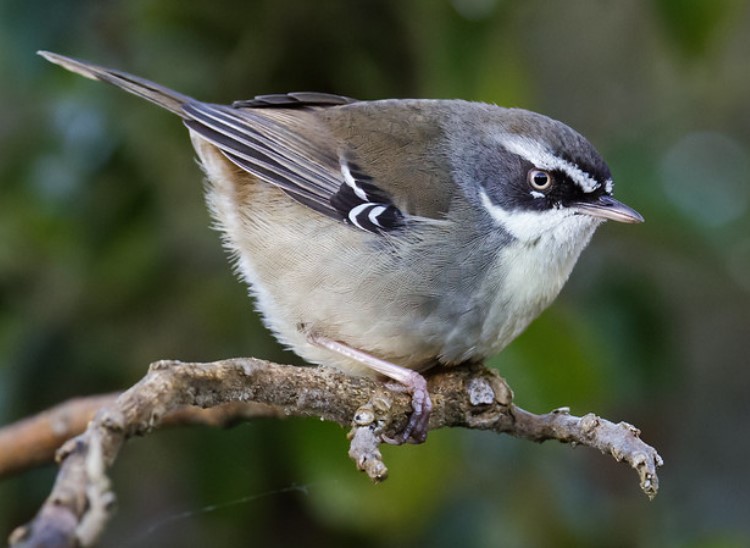Habitats and Behavior: The white-browed scrubwren (Sericornis frontalis) is one of the most widespread, abundant, and familiar of Australia’s small ground-feeding birds, occurring from northern Queensland south around the coast to Tasmania and Shark Bay, Western Australia.
Throughout that vast range, it lives in one type of habitat: close and usually moist shrubberies along creeks, the sides of ridges, the fringes of mangroves, and coastal heath and mallee scrubs. It even persists in pockets of blackberries after the surrounding vegetation has been cleared.
In their habitat, the scrubwrens are sedentary. Established pairs hold to a permanent territory of 1 to 5 hectares year-round but often include several additional adults and immatures in their group, probably some of their young from previous nesting’s. Thus, the members of a band keep up constant soft chatter as they travel to maintain contact.
This changes to harsh staccato churring if they are disturbed; one or two birds then climb up into shrubbery to check the cause. Most groups often include only one adult female, the mate of the dominant male. She may build and incubate unaided, but the male and other members of the group assist in feeding the young.
Geographical variation: The geographical variation in plumage marks and tones matches the wide distribution of this species. There are at least nine races that fall into four main groups. One occurring down the east coast of Queensland to the New South Wales border has a plain buff-white throat and breast, a clear black-and-white face pattern with dusky running over the ears, and a white-tipped tail.
Another range around the mainland coast from the Queensland border to Mt Lofty Ranges, South Australia, is similar but has a black-streaked throat, facial black restricted to the lores (males), and a brown-tipped tail. In Tasmania, there is a third group, larger and darker, with obscure face patterns and dark-tipped tails. Lastly, there is the ‘Spotted’ Scrubwren around the western coast from Shark Bay east to the South Australian gulfs; it has the face pattern of eastern races, a heavily black-spotted throat and breast, and a white-tipped tail.
Identification: The male plumage is variable according to the geographical range. Upper parts dark olive-brown to mid-cinnamon-brown, crown darker; rump lighter. Wing coverts are dusky to black with two dull to white bars of varying extent. The tail has an indistinct or clear subterminal black band near the tip and, at times, a white tip. The face is patterned with a distinct white brow, a white spot under the eye, and a white malar line, dull in one race; lores black or dusky, extending over ears in one race.
Also, the throat and breast are white to pale yellowish cream or buff-grey, plain, lightly streaked, or heavily spotted black; the rest of the underparts are dull white or buff; the flanks are cinnamon to olive-grey. Eye cream. The bill is dusky with paler under base. Feet pink-brown. The female bird is a little duller, with brown lores. The immature bird’s head is smoky brown, its upper and underparts were washed chocolate brown, and its face markings are much duller.
Feeding: The group forages as a loose party, hop-searching briskly over the shrubbery floor and occasionally up among low branches, gleaning a range of insects—beetles, weevils, bugs, and moths—as well as spiders and seeds. Most feeding is done under cover, with the birds moving from patch to patch of shrubbery with short dipping flights within a meter of the ground.
Life Span: If they survive their first year as inexperienced juveniles, white-browed scrubwrens may live as long as 15 years.
Vocalizations: The white-browed scrubwren call is soft churrs and chips in contact. The harsh, repeated staccato churred tzz-tzzz-t-tzzz in alarm. White-browed scrubwren songs consist of a rapidly repeated series of whistled notes on the same pitch, t’seer-t’seer-t’seer; often many other notes are given in softer undertones.
Nesting and Breeding: White-browed scrubwren nesting and breeding occur in July–January. Nest a coarse dome, with a rounded side entrance, of bark strips, rootlets, and grasses; usually lined with feathers; hidden on or near the ground amid tangled undergrowth, in a clump of grass, under a bank, wedged between tree trunks, or behind hanging or fallen bark.
Eggs and Incubation: The bird lays two or three eggs; color varies from grey-white to pale buff, finely speckled with darker spotting, and a well-defined zone at the larger end. The eggs are oval to oblong-oval in shape and measure about 9 x 14 mm. Most likely, a female handles the incubation phase. Males and other members help with feeding.
Distribution: White-browed scrubwren found in Atherton Tableland, Queensland, south around the coast and adjacent mountains to Shark Bay and offshore islands, Western Australia; also Tasmania and the islands of Bass Strait.
Family: White-browed scrubwren placed in the family Pardalotidae to the order Sericornis in the Sibley-Ahlquist taxonomy.
Races: There are about nine races.
Other Names: The bird is also known as Buff-breasted Scrubwren, Brown Scrubwren, and Spotted Scrubwren.
Size: The white-browed scrubwren measures about 110–140 mm in length.
Read More: Atherton Scrubwren (Sericornis keri)
